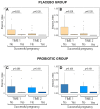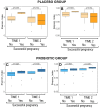Ligilactobacillus salivarius CECT5713 Increases Term Pregnancies in Women with Infertility of Unknown Origin: A Randomized, Triple-Blind, Placebo-Controlled Trial
- PMID: 40507130
- PMCID: PMC12158033
- DOI: 10.3390/nu17111860
Ligilactobacillus salivarius CECT5713 Increases Term Pregnancies in Women with Infertility of Unknown Origin: A Randomized, Triple-Blind, Placebo-Controlled Trial
Abstract
Background/Objectives: Unexplained infertility is a worldwide problem affecting a significant proportion of couples of reproductive age. Recent studies suggest that alterations in the vaginal microbiota are related to female infertility, while supplementation with some probiotic strains has been shown to improve pregnancy rates in couples experiencing this problem. This study aimed to evaluate the impact of oral administration of Ligilactobacillus salivarius CECT5713 on pregnancy success rates in couples with unexplained infertility prior to in vitro fertilization (IVF). Methods: Seventy couples were randomized to receive either a placebo or a probiotic intervention (one capsule per day containing an excipient only or 3 × 109 viable cells of L. salivarius CECT5713 plus an excipient, respectively); 57 couples completed the study. Baseline data on demographics, health status (including gynecological and reproductive history), and lifestyle habits were collected. Vaginal swabs and semen samples were obtained from each couple before the intervention and immediately prior to IVF or upon confirmed pregnancy and were analyzed for microbiological (using both culture-dependent and -independent methods) and immunological profiles. Results: Oral administration of L. salivarius CECT5713 in couples with unexplained infertility scheduled for IVF resulted in a significantly higher pregnancy success rate (48.1%) compared to the placebo group (20.0%) (one-tailed Chi-square test; p < 0.024). The probiotic intervention improved both vaginal and semen immunological profiles, with no substantial changes observed in their microbial composition. Conclusions: These preliminary findings support the potential of L. salivarius CECT5713 supplementation to enhance fertility outcomes in couples with unexplained infertility.
Keywords: Ligilactobacillus salivarius; TGFβ1; VEGF; assisted reproduction techniques; infertility; probiotics; semen microbiota; vaginal microbiota.
Conflict of interest statement
C.D.M., R.B.-R., M.E.S. and M.O. are workers for the Kerry Group, which is the owner of the strain tested in this trial and protected by patent (PCT/ES2020/070382). The members of the company participate as authors because of their roles in the study design, the interpretation of data, and the writing of the manuscript.
Figures




Similar articles
-
Antioxidants for male subfertility.Cochrane Database Syst Rev. 2022 May 4;5(5):CD007411. doi: 10.1002/14651858.CD007411.pub5. Cochrane Database Syst Rev. 2022. PMID: 35506389 Free PMC article.
-
ProVag: the effect of oral probiotics on the vaginal microbiota composition in women receiving medical assisted reproduction in a Dutch fertility clinic - protocol of a randomised, placebo-controlled, double-blind study.BMJ Open. 2025 Jul 8;15(7):e096959. doi: 10.1136/bmjopen-2024-096959. BMJ Open. 2025. PMID: 40633953 Free PMC article.
-
In vitro fertilisation for unexplained subfertility.Cochrane Database Syst Rev. 2005 Apr 18;(2):CD003357. doi: 10.1002/14651858.CD003357.pub2. Cochrane Database Syst Rev. 2005. Update in: Cochrane Database Syst Rev. 2012 Apr 18;(4):CD003357. doi: 10.1002/14651858.CD003357.pub3. PMID: 15846658 Updated.
-
Effect of the vaginal live biotherapeutic LACTIN-V (Lactobacillus crispatus CTV-05) on vaginal microbiota and genital tract inflammation among women at high risk of HIV acquisition in South Africa: a phase 2, randomised, placebo-controlled trial.Lancet Microbe. 2025 Jun;6(6):101037. doi: 10.1016/j.lanmic.2024.101037. Epub 2025 Apr 4. Lancet Microbe. 2025. PMID: 40194532 Free PMC article. Clinical Trial.
-
In vitro fertilisation for unexplained subfertility.Cochrane Database Syst Rev. 2002;(2):CD003357. doi: 10.1002/14651858.CD003357. Cochrane Database Syst Rev. 2002. Update in: Cochrane Database Syst Rev. 2005 Apr 18;(2):CD003357. doi: 10.1002/14651858.CD003357.pub2. PMID: 12076476 Updated.
References
-
- WHO ICD-11. 2020. [(accessed on 22 May 2025)]. Available online: https://www.who.int/news-room/fact-sheets/detail/infertility.
Publication types
MeSH terms
Grants and funding
LinkOut - more resources
Full Text Sources
Medical

